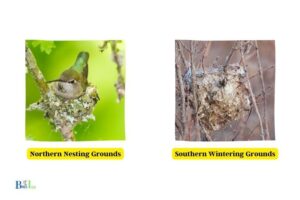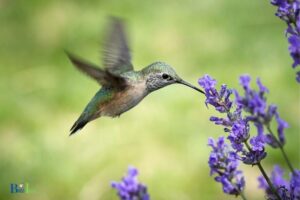Black Chinned Vs Ruby Throated Hummingbird: Explore!
Black Chinned and Ruby Throated Hummingbirds are two of the most common species of hummingbird in North America.
Both species are incredibly agile and feed on nectar from flowers, insects and small fruits.
However, there are significant differences between them in size, coloration, flight behavior and habitat preference.
Comparatively, the Black Chinned Hummingbird is slightly larger at four inches in length.
In contrast, the Ruby Throated Hummingbird is mainly bronzy green, with distinctive scarlet red spots on its throat and white feathers on its chin.
In contrast, the Black Chinned Hummingbird prefers to inhabit breezy meadows or wooded groves.
While both of these species are enchanting and fascinating to observe, they each display unique characteristics that distinguish them from one another.
The Black-chinned hummingbird’s defining black chin and purple band provide a stark contrast to the Ruby-throated hummingbird’s gleaming red throat.
Their distribution across north and Central America also makes them species of interest to bird
12 Features of Black Chinned and Ruby Throated Hummingbirds
| Feature | Black-Chinned Hummingbird | Ruby-Throated Hummingbird |
| Scientific Name | Archilochus alexandri | Archilochus colubris |
| Size | 3.25 inches | 3.5 inches |
| Weight | 0.1 oz | 0.11 oz |
| Wingspan | 4.1 – 4.3 inches | 3.1 – 4.3 inches |
| Lifespan | Up to 10 years | Up to 9 years |
| Diet | Nectar, insects, spiders | Nectar, insects, spiders |
| Habitat | Deserts, mountains, and coastal regions | Broad-leaved forests, pine forests, and gardens |
| Breeding Season | April – July | April – July |
| Nest Type | Cup-shaped on a tree branch | Cup-shaped on a tree branch |
| Egg Color | White | White |
| Flight Speed | Up to 60 mph | Up to 55 mph |
| Distinct Feature | Male has a black chin with a purple band below | Male has a bright red throat which can appear black in some lighting |
Key Takeaway

Five Facts About: Black Chinned and Ruby Throated Hummingbirds
DID YOU KNOW
Around 200 species of hummingbirds are recorded in the world, with more than one-third in the Americas.
North American Hummingbirds
North American Hummingbirds are some of the most stunning and fascinating birds found in the continent.
They are well known for their fast and acrobatic flight, their bright and colorful feathers, and their incredible hovering capabilities.

Here are some of the most common North American hummingbird species:
Anna’s Hummingbird: This species is found in western parts of North America, particularly in California. It has a green back, with a reddish throat and forehead.
Black-chinned Hummingbird: These hummingbirds are found in the western parts of North and Central America. They have glossy green upperparts, a black chin and throat, a white belly, and a forked tail.
Broad-tailed Hummingbird: This species is found in the western parts of North America. They have a green back and crown, with a buffy-white belly, and a bright red throat.
Rufous Hummingbird: This species is found in western and northwestern parts of North America. They have a bright orange to red throat, orange-tinted flanks, and a long, dark tail.
Ruby-throated Hummingbird: This species is found in eastern parts of North America. They have a green back with a white throat, and a black chin and forehead.
Hummingbirds are crucial to the North American environment, as they are important pollinators of native plants. They also provide food for a variety of other species, including larger birds and bats.
Comparing Black Chinned and Ruby Throated Hummingbirds
Black chinned and ruby throated hummingbirds are two species of birds found in North America. Both species have a similar body structure, but there are some key differences between them.

Size:
The black chinned hummingbird is usually slightly larger than the ruby throated hummingbird. The black chinned hummingbird measures 3.25 inches long, while the ruby throated hummingbird is usually only 2.75 inches long.
Color:
The black chinned hummingbird has predominantly dark green and black feathers, while the ruby throated hummingbird is mostly iridescent green and white.
Habitat:
While both species can be seen in the same areas, the black chinned hummingbird prefers more arid, desert-like climates, while the ruby throated hummingbird prefers more humid areas, closer to rivers and streams.
Migratory Patterns:
The black chinned hummingbird tends to migrate further south in the winter than the ruby throated hummingbird.
Both species of hummingbird are beautiful to watch and have many similarities, but they also have distinct differences that make them unique.
“The beauty of the hummingbird reminds us of the miracle of nature and the wonders of life.”
birdsidea
Size Differences
The size of an object, such as a building, can depend greatly on its purpose. Different types of buildings have different size requirements and limitations in order to fulfill their purpose.

Here are some size differences between common types of buildings:
- Churches tend to be large and ornate, often with a large steeple, to create an awe-inspiring atmosphere.
- Schools are usually quite large, in order to accommodate several classrooms, a gym, and library.
- Restaurants come in many different sizes, but usually tend to be small and cozy.
- Shopping malls are large, with several stories and sections dedicated to different types of stores.
- Houses come in various sizes, depending on the needs of the family.
Overall, the size of the building depends on its purpose and the needs of the users. Different types of buildings can vary greatly in size, depending on how they are designed and used.
Coloration Differences
Coloration differences between organisms can be caused by a variety of factors.
These include:

- Adaptation to a particular environment: Organisms may adapt to their environment by developing coloration that helps them blend in, or stand out.
- Social status: Within a species, different coloration may be associated with a higher or lower social status.
- Mating preferences: Different coloration can indicate certain desirable characteristics to potential mates.
These are just a few of the many possible explanations for coloration differences between organisms.
The specific factors behind the differences will vary depending on the type of organism in question.
Flight Behaviour Differences
Flight behaviour of birds vary according to their species and size. Some birds fly high in the sky, while others prefer to stay close to the ground.
Small birds such as finches, sparrows and warblers tend to fly in large flocks, often in a V-formation.

This is to save energy and create less drag in the air. These birds generally fly high in the sky, and have a shorter flight range than larger birds of prey.
Larger birds, such as eagles and hawks, prefer to fly alone or in pairs. They travel long distances, often soaring on air currents. Eagles and hawks have powerful wings and can also hover or fly in circles to spot their prey.
Birds of prey, such as falcons, are known for their steep dives and quick turns. They use their agility to chase and catch other birds or small animals.
In addition to flying differently, birds also display different vocalizations during flight. Small birds such as warblers sing while flying, while birds of prey make loud calls and screeches to communicate with each other.
Habitat Preference Differences
Habitat preference is an important factor that influences the survival of animals in their natural environment.
Different species of animals show distinct preferences for their habitats due to factors like climate, food availability, and predation risk.

Some common habitat preferences among animals are:
- Aquatic animals: Marine and freshwater habitats, coral reefs, lagoons, estuaries, and wetlands.
- Terrestrial animals: Grasslands, scrublands, deserts, forests, and tundras.
- Birds: Open grasslands, forests, wetlands, and coastal areas.
- Reptiles: Deserts, grasslands, and wetlands.
Habitat preferences also vary within a species. For example, some species of birds may prefer open grasslands while others may prefer forests or wetlands. Similarly, some reptiles may prefer deserts while others may prefer grasslands or wetlands.
Overall, habitat preference is an important factor that determines the survival of animals in their natural environment.
By understanding the different preferences of different species, we can ensure better conservation of their habitats, and ultimately, their survival.
Importance of Hummingbirds in the Environment
Hummingbirds are an important part of the environment, playing several key roles in ecosystems around the world.

Here are some of the most significant contributions these tiny birds make:
Pollination: Hummingbirds feed on nectar and in the process, pick up and spread pollen from flower to flower, aiding in the pollination process.
Predators: Hummingbirds help to keep the insect population in check by hunting for insects that form part of their diet.
Seed Dispersal: By consuming berries and other fruits, hummingbirds disperse the seeds in their droppings, thereby aiding in the natural regeneration of plants.
Adaptability: The diminutive size of hummingbirds means they can live in a variety of habitats, from deserts to jungles and mountain slopes, helping to maintain the balance of species in ecosystems.
Overall, hummingbirds play an important role in keeping the environment healthy, providing essential services that would otherwise be difficult or impossible to accomplish.
FAQ of Black Chinned Vs Ruby Throated Hummingbird
What is the difference between a Black Chinned and a Ruby Throated Hummingbird?
The Black Chinned Hummingbird is native to the western United States, while the Ruby Throated Hummingbird is mostly found in the eastern United States and parts of Mexico and Canada.
Additionally, the Black Chinned Hummingbird typically has a black chin, while the Ruby Throated Hummingbird has a red throat.
What is the habitat of the Black Chinned Hummingbird?
Additionally, it can be seen in a variety of open habitats, including grasslands, meadows, orchards, and yards.
What is the average weight of a Ruby Throated Hummingbird?
What does the Black Chinned Hummingbird eat?
What is the preferred nesting site of the Ruby Throated Hummingbird?
It will also build nests on man-made structures, such as mailboxes, outdoor lighting fixtures, and window boxes.
Conclusion
The Black Chinned and Ruby Throated Hummingbirds are two of the most common species of hummingbird in North America.
Though they share a few traits, they differ considerably in size, coloration, flight behavior and habitat preference.
These variations mean that both species are crucial to their respective ecosystems and can live together in a harmonious balance.






